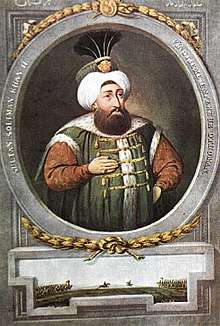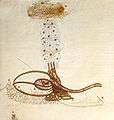Suleiman II of the Ottoman Empire
Suleiman II (15 April 1642 – 22 June 1691) (Ottoman Turkish: سليمان ثانى Süleymān-i sānī) was the Sultan of the Ottoman Empire from 1687 to 1691. After being brought to the throne by an armed mutiny, Suleiman and his grand vizier Fazıl Mustafa Pasha were successfully able to turn the tide of the War of the Holy League, reconquering Belgrade in 1690, as well as carrying out significant fiscal and military reforms.
| Suleiman II سلیمان ثانی | |||||
|---|---|---|---|---|---|
| Sultan of the Ottoman Empire Kayser-i Rûm Custodian of the Two Holy Mosques Ottoman Caliph | |||||
 | |||||
| 20th Ottoman Sultan (Emperor) | |||||
| Reign | 8 November 1687 – 22 June 1691 | ||||
| Predecessor | Mehmed IV | ||||
| Successor | Ahmed II | ||||
| Born | 15 April 1642 Topkapı Palace, Constantinople, Ottoman Empire | ||||
| Died | 22 June 1691 (aged 49) Edirne Palace, Edirne, Ottoman Empire | ||||
| Burial | |||||
| Consorts | Hatice Kadın[1] Behzad Kadın[1] İvaz Kadın[1] Süğlün Kadın[1] Şehsuvar Kadın[1] Zeyneb Kadın[1] | ||||
| |||||
| Dynasty | Ottoman | ||||
| Father | Ibrahim | ||||
| Mother | Aşub Sultan | ||||
| Religion | Sunni Islam | ||||
| Tughra | |||||
Early life
Suleiman II was born on 15 April 1642 at Topkapı Palace in Constantinople, the son of Sultan Ibrahim and Aşub Sultan, a Serb woman originally named Katarina.[2][3][4] Suleiman was only 3 months younger than his half-brother Mehmed IV, who was born on 2 January 1642. After the deposition and execution of his father in 1648, Suleiman's half-brother Mehmed came to the throne. On 21 October 1649, Suleiman along with his brothers Mehmed and Ahmed were circumcised. [5]
In 1651, Suleiman was confined in kafes (cage), a kind of luxurious prison for princes of the blood within the Topkapı Palace (it was designed to ensure that none could organize a rebellion), and he stayed there for 36 years until he took the throne in 1687.
In 1656, Şeyhülislam Hocazade Mesud Efendi and other grand viziers tried to put Suleiman but failed and some were executed some were punished. After the defeat of Vienna in 1683, Suleiman and Ahmed were brought to Istanbul and the Şimşirlik Kasnna was closed. [6]
Reign
Suleiman II went to the Eyüp Sultan Mosque on 3 December 1687, and a sword was besieged by Şeyhülislam Debbağzade Mehmed Efendi and the Janissary Ağa Mustafa Ağa. The next day, he went to the first Friday salute at the Hagia Sophia Mosque. The Suleymaniye Mosque preacher Aralızade Abdül Efendi, He was appointed every day by the sultan of the Süleymaniye Mosque. [7] Recep Pasha who ran before Suleiman’s accession was found in house at Çatalca and was executed in front of Bab-I-Humayun. [7] In the first months of 1688, when the news of the Venetian invasion of the Peloponnese and the Attic burning, the Austrian border was also invaded. [8]
Shortly before he assumed the throne, the Ottomans suffered a major defeat at the second Battle of Mohács in 1687. In 1688, Suleiman II urgently requested the Mughal Emperor Aurangzeb for assistance against the rapidly advancing Austrians, during the Ottoman–Habsburg War, but most Mughal forces were engaged in the Deccan Wars and Aurangzeb ignored Suleiman's request to commit to any formal assistance to their desperate Ottoman allies.[9]
In order to cover the treasury deficit, the trust of hamr (drink) started to operate again. It was the public budget deficit, it was banned but people publicly sold drinks in taverns, Istanbul and Galata, in taverns and even at home. [8] While Suleiman managed to demolish the alcohol shops the owners starting bringing more alcohol. The tax on alcohol was 8 gold coins.[8]
Suleiman II shrewdly appointed Köprülü Fazıl Mustafa Pasha as his Grand Vizier on 25 October 1689, leading to the reconquest of Belgrade in 1690. Even so, when Russian Empire joined an alliance of European powers, the Ottomans lost the support of their Crimean vassals, who were forced to defend themselves from Russian invasion. Under Köprülü's leadership, the Ottomans halted an Austrian advance into Serbia and crushed an uprising in Macedonia and Bulgaria until Köprülü Fazıl Mustafa Pasha was killed in the Battle of Slankamen by Austrian forces.
Death
Suleiman II was in Coma and was brought to Edirne on 8 June 1691. He died on 22 June 1691 and his body was put in icebox. His brother Ahmed was enthroned and his body was buried in Suleiman the Magnificent’s tomb at Süleymaniye Mosque in Istanbul. [10]
Gallery
 Tughra of Suleiman II
Tughra of Suleiman II Suleiman II in Croatia
Suleiman II in Croatia- Coin of Suleiman II
 Suleiman II
Suleiman II Suleiman II
Suleiman II The Ottoman Army after suffering a major defeat during the Second Battle of Mohács
The Ottoman Army after suffering a major defeat during the Second Battle of Mohács
See also
Sources
- M. Çağatay Uluçay, Padişahların Kadınları ve Kızları, Ötüken Publications, p. 113.
- "Sultan II. Süleyman Han". Republic of Turkey Ministry of Culture and Tourism. Retrieved 2009-02-06.
- Günseli İnal; Semiramis Arşivi (2005). Semiramis: Sultan'ın gözünden şenlik. YKY. p. 27. ISBN 978-975-08-0928-6.
Siileyman'in annesi Sirp Katrin yani Dilasiip Hatun
- Ali Kemal Meram (1977). Padişah anaları: resimli belgesel tarih romanı. Öz Yayınları. p. 325.
- Sakaoğlu 2015, p. 271.
- Sakaoğlu 2015, p. 272.
- Sakaoğlu 2015, p. 274.
- Sakaoğlu 2015, p. 276.
- Mughal-Ottoman relations: a study of political & diplomatic relations ... - Naimur Rahman Farooqi - Google Boeken. Books.google.com. 1989. Retrieved 29 April 2012.
- Sakaoğlu 2015, p. 279.
External links
![]()
Suleiman II of the Ottoman Empire House of Osman Born: 15 April 1642 Died: 22 June 1691[aged 49] | ||
| Regnal titles | ||
|---|---|---|
| Preceded by Mehmed IV |
Sultan of the Ottoman Empire 8 November 1687 – 22 June 1691 |
Succeeded by Ahmed II |
| Sunni Islam titles | ||
| Preceded by Mehmed IV |
Caliph of the Ottoman Caliphate 8 November 1687 – 22 June 1691 |
Succeeded by Ahmed II |
